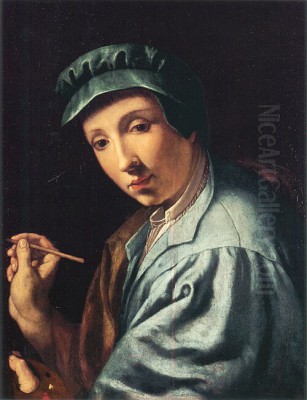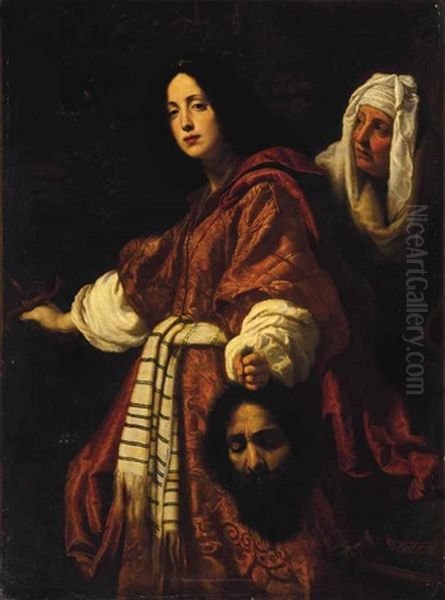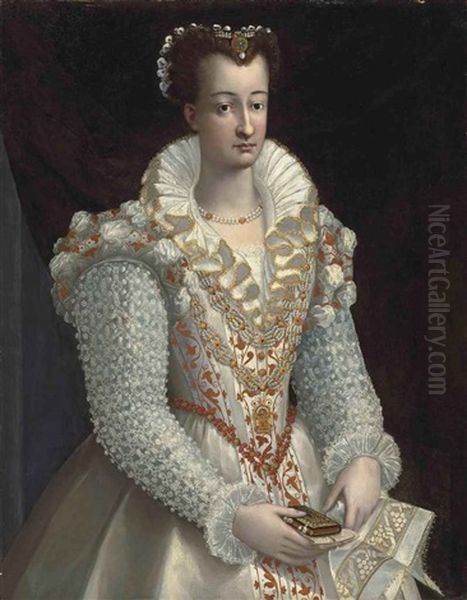Introduction: A Bridge Between Eras

Alessandro di Cristofano Allori, born in Florence on May 31, 1535, stands as a pivotal figure in the twilight of the Italian Renaissance. Active primarily in his native city until his death on September 22, 1607, Allori navigated the complex artistic currents of the late sixteenth century. He was a prominent exponent of Mannerism, the sophisticated and artificial style that followed the High Renaissance, yet his long career also witnessed the nascent stirrings of the Baroque. As the principal pupil and adopted son of the renowned Mannerist master Agnolo Bronzino, Allori inherited a legacy of technical brilliance and courtly elegance, which he adapted and perpetuated through his own prolific output of portraits, religious narratives, allegories, and designs for decorative schemes.
Early Life and the Mantle of Bronzino
Alessandro Allori's entry into the world of art was shaped by personal loss and profound artistic inheritance. His father, Cristofano di Lorenzo, a swordsmith, passed away in 1540 when Alessandro was merely five years old. Recognizing the boy's potential, the celebrated court painter Agnolo di Cosimo, universally known as Bronzino, who was a close friend (and possibly a relative) of the family, took the young Alessandro into his home and workshop. Bronzino became not only his teacher but also his adoptive father, providing rigorous training in drawing, painting, and the refined aesthetics favoured by the Medici court.
This apprenticeship was transformative. Bronzino was himself a pupil of Jacopo Pontormo, one of the pioneers of Florentine Mannerism. Bronzino perfected a style characterized by crystalline clarity, enamel-like surfaces, cool, often vibrant colours, complex allegories, and psychologically penetrating, yet emotionally reserved, portraits. Alessandro absorbed these qualities deeply, learning the meticulous techniques and sophisticated compositional strategies that defined his master's work. So close was their association that Alessandro often added "Bronzino" to his own signature, sometimes leading to confusion but also signalling his artistic lineage and ambition. His early works clearly demonstrate this profound influence, displaying a similar emphasis on precise draughtsmanship and polished finish.
The Roman Sojourn: Expanding Horizons

Around 1554, at the age of nineteen, Allori embarked on a crucial journey to Rome, a customary destination for ambitious artists seeking to study the masterpieces of antiquity and the High Renaissance. This period, lasting until approximately 1560, proved vital for his artistic development, exposing him to influences beyond Bronzino's immediate circle. Foremost among these was the overwhelming power of Michelangelo. Allori diligently studied Michelangelo's frescoes in the Sistine Chapel, particularly the Last Judgment, and his sculptures, absorbing the dynamic energy, complex anatomy, and expressive potential of the human form that defined Michelangelo's terribilità.
The experience in Rome broadened Allori's stylistic vocabulary. While retaining the Mannerist elegance inherited from Bronzino, his compositions began to incorporate more muscular figures, intricate poses, and a greater sense of anatomical understanding, directly reflecting his engagement with Michelangelo's art. He also studied the works of Raphael, whose harmonious compositions and graceful figures offered a counterpoint to Michelangelo's intensity. This Roman sojourn equipped Allori with a wider range of artistic models and solutions, enriching the sophisticated Florentine Mannerism he had learned in Bronzino's studio.
Mature Style: The Epitome of Florentine Mannerism
Upon returning to Florence around 1560, Allori rapidly established himself as a leading painter, inheriting Bronzino's mantle as one of the city's most sought-after artists, particularly after Bronzino's death in 1572. His mature style represents a culmination of late Florentine Mannerism. It is characterized by an emphasis on disegno (drawing and design), intricate and often crowded compositions, elongated figures arranged in elegant, serpentine poses (figura serpentinata), and a palette that, while sometimes vibrant, often retained a cool, polished quality reminiscent of Bronzino.
Allori excelled in creating complex allegorical and mythological scenes, often imbued with the intellectual sophistication favoured by the Medici court and Florentine academies. His figures, though anatomically studied, often prioritize grace and artificiality over naturalism, embodying the Mannerist pursuit of stylized beauty. He became a master of intricate detail, rendering luxurious fabrics, jewels, and architectural settings with meticulous precision. This refinement made him particularly suited to the demands of courtly patronage, where artifice and elegance were highly valued. He received numerous commissions from the ruling Medici family and the Florentine nobility, solidifying his position within the city's artistic elite.
Major Works and Commissions
Alessandro Allori's prolific career yielded a vast body of work across various genres. His contributions to portraiture, large-scale decorative projects, religious painting, and tapestry design cemented his reputation.
Portraiture: Capturing the Florentine Elite

Following in Bronzino's footsteps, Allori became a highly accomplished portrait painter. His portraits typically depict the Florentine aristocracy and members of the Medici family with a characteristic blend of formal elegance and psychological insight, though often with less emotional distance than Bronzino's iconic images. He rendered the rich costumes and status symbols of his sitters with painstaking detail, emphasizing their social standing.
A notable example is the Portrait of a Lady with her Son (c. 1574), which showcases his ability to combine refined detail in clothing and jewellery with a sense of dignified presence. While sometimes criticized for a certain stiffness compared to the burgeoning naturalism elsewhere in Italy, his portraits were highly valued for their technical polish and faithful representation of likeness within the conventions of courtly Mannerism. He painted portraits of key figures like Francesco I de' Medici and his wife Joanna of Austria, contributing significantly to the visual record of the Florentine court.
The Studiolo of Francesco I: A Mannerist Jewel Box
One of Allori's most significant contributions was his participation in the decoration of the Studiolo of Francesco I in the Palazzo Vecchio (c. 1570-1572). This small, barrel-vaulted room was conceived by Vincenzo Borghini and Giorgio Vasari as an intricate microcosm of the universe, a private space for the Grand Duke to house his collection of rare and precious objects. Allori worked alongside other leading Florentine artists, including Vasari himself, Giovanni Maria Butteri, Jacopo Zucchi, and Mirabello Cavalori.
Allori's contribution, the Pearl Fishers (Pesca delle Perle), is a quintessential example of his mature Mannerist style. The painting depicts numerous nude and semi-nude figures diving and collecting pearls in a dynamic, almost balletic composition. The elongated limbs, complex poses, and cool, shimmering colours are characteristic of his work from this period. The painting fits perfectly within the Studiolo's complex iconographic program, which related the artworks to the natural elements and the objects collected by the Duke. Allori's involvement in this prestigious project underscores his high standing in the Florentine artistic community.
Religious Works: Faith in the Mannerist Idiom
Allori was also a prolific painter of religious subjects, producing numerous altarpieces and frescoes for churches in Florence and Tuscany. His religious works often blend Mannerist elegance with the didactic clarity increasingly favoured by the Counter-Reformation. He painted several versions of the Last Supper, including one for the refectory of Santa Maria Novella. These works often feature crowded compositions, elaborate architectural settings, and figures displaying heightened emotional states, albeit rendered with Mannerist grace.
He contributed frescoes to important Florentine churches, such as Santissima Annunziata, where he painted scenes from the life of the Virgin. His Last Judgment, painted for the Montauti Chapel in the same church, demonstrates the enduring influence of Michelangelo, adapted to Allori's own polished style. While adhering to Mannerist conventions, some of his later religious works show a move towards greater legibility and emotional directness, perhaps reflecting the influence of Counter-Reformation theologians and artists like Santi di Tito, who advocated for a clearer, more accessible religious art.
Tapestry Design: Weaving for the Medici
Beyond painting, Allori played a significant role in the Arazzeria Medicea, the tapestry manufactory established by the Medici. He produced numerous cartoons (full-scale designs) for tapestries, translating complex narratives and allegories into a medium suited for decorating the vast walls of ducal palaces. This work required a strong sense of design and the ability to adapt pictorial compositions for weaving. His tapestry designs often featured intricate borders, rich details, and the same elegant figural style found in his paintings, contributing to the luxurious visual culture of the Medici court.
Workshop, Collaborations, and Influence
Like most successful artists of his time, Alessandro Allori maintained a large and active workshop to help manage his numerous commissions. He trained a significant number of pupils who went on to have careers of their own, ensuring the continuation of his stylistic lineage, albeit often adapted to newer trends. His most famous pupil was his own son, Cristofano Allori (1577-1621), who became a leading figure of the early Florentine Baroque, known for his rich colour, dramatic lighting, and intense emotionalism, moving decisively away from his father's late Mannerist style.
Other notable students and collaborators included Giovanni Maria Butteri (who also worked on the Studiolo), Cristoforo del Altissimo (known for his series of portraits of famous men for Cosimo I), Cesare Dandini, Alessio Lomi, and Giovanni Bizzelli. Allori often collaborated with other artists on large decorative projects, a common practice in the period. His collaboration with Giorgio Vasari on the preparations for the wedding of Francesco I and Joanna of Austria, and on the Studiolo project, highlights his integration into the mainstream artistic enterprises of Medici Florence.
Later Years and Stylistic Considerations
Allori's later career continued productively into the early 17th century. While he remained largely faithful to the Mannerist principles he had mastered, his later works occasionally show subtle shifts. Some paintings exhibit slightly warmer colours or a greater interest in naturalistic detail, perhaps reflecting the changing artistic climate influenced by reformers like Santi di Tito or the early Baroque innovations emanating from Rome, particularly the work of Caravaggio and Annibale Carracci.
However, Alessandro himself never fully embraced the dramatic naturalism or emotional intensity of the emerging Baroque style. That step would be taken more decisively by his son, Cristofano. There is a famous anecdote concerning a painting of Judith with the Head of Holofernes, where the model for Judith was the painter's mistress and Holofernes a self-portrait. While Alessandro did paint this subject, this particular story and the intensely Caravaggesque style associated with it are more strongly linked to Cristofano Allori's celebrated version (c. 1613). Alessandro's work remained rooted in the elegance and artifice of Mannerism, even as the style itself was falling out of favour. Some critics argue his adherence to this style became a limitation, leading to works that could seem repetitive or lacking in emotional depth compared to the new Baroque sensibility.
Relationship with Contemporaries
Alessandro Allori operated within a vibrant and competitive Florentine art scene. He was a contemporary of figures like Giorgio Vasari, the painter, architect, and art historian whose influence dominated Florentine art for decades. Allori collaborated with Vasari but also competed with him and others for prestigious commissions. Another key contemporary was Santi di Tito, whose move towards a clearer, more naturalistic style, influenced by Counter-Reformation ideals, offered a distinct alternative to Allori's persistent Mannerism.
Other notable Florentine artists of the period included Jacopo Ligozzi, known for his detailed scientific illustrations and paintings, and younger figures like Ludovico Cigoli and Gregorio Pagani, who were instrumental in introducing the Baroque style to Florence. Allori's relationship with these artists was complex, involving collaboration, competition, and stylistic dialogue. While respected for his technical skill and his position as Bronzino's heir, his adherence to Mannerism sometimes drew criticism from those favouring newer trends. His works were occasionally mistaken for those of other masters, a testament perhaps to his technical skill but also hinting at the perceived derivativeness noted by some critics.
Legacy and Critical Reception
Alessandro Allori holds a secure, if sometimes debated, place in art history. He is widely regarded as the last major exponent of the Florentine Mannerist tradition, embodying its sophisticated elegance and technical refinement. His prolific output and prominent role in Medici patronage made him a dominant figure in Florentine art during the late 16th century. He successfully carried forward the legacy of Bronzino, adapting it through his study of Roman masters like Michelangelo.
However, his critical reception has been mixed. While praised for his draughtsmanship, intricate compositions, and mastery of the Mannerist idiom, he has also been criticized for a perceived lack of originality, emotional coldness, and an overly artificial or "frozen" quality in his figures, particularly when compared to the dynamism of the emerging Baroque. Some art historians view his work as representing the decline of Mannerism into academic formula, while others emphasize his skill and importance as a transitional figure whose workshop nurtured the next generation, including his son Cristofano, who would fully embrace the Baroque. His influence extended through his numerous students, shaping Florentine painting in the early 17th century.
Conclusion: The Enduring Mannerist
Alessandro Allori died in Florence in 1607, leaving behind a substantial legacy. As the heir to Bronzino and a master deeply influenced by Michelangelo, he synthesized key elements of 16th-century Florentine art. His career spanned a period of significant stylistic change, and while he remained largely committed to the Mannerist aesthetic, his work reflects the complex artistic environment of his time. Through his paintings, portraits, frescoes, and designs, Allori made significant contributions to the visual culture of Medici Florence, serving as a crucial link between the High Renaissance masters he studied, the Mannerist tradition he inherited and perfected, and the Baroque era that would follow. He remains a key figure for understanding the art of late Renaissance Florence, a master of elegance and design in an age of transition.